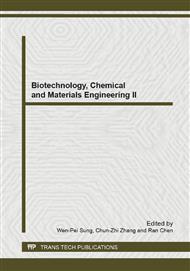[1]
Nuhoglu Y Malkoc E. Thermodynamic and kinetic studies for environmentaly friendly Ni(Ⅱ)biosorption using waste pomace of olive oil factory. Bioresource Technology. 100 (2009), pp.2375-2380
DOI: 10.1016/j.biortech.2008.11.016
Google Scholar
[2]
Brim H, McFarlan S C, Fredrickson J K, et al. Nat. Biotechnol.18(2000), pp.85-90
Google Scholar
[3]
Solisio C, Lodi A, Soletto D, et al. Cadmium biosorption on Spirulina platensis biomass. Bioresouree Technology. 99(2008), pp.5933-5937
DOI: 10.1016/j.biortech.2007.11.002
Google Scholar
[4]
Mao Gennian, Xu Mudan, Huang Jianwen,et al. Analysis and detection of toxic and hazardous substances in the environment. BeiJing: Chemical Industry Press (2004).
Google Scholar
[5]
Umrania V V. Bioremediation of toxic heavy metals using acidothermophilic autotrophies. Bioresource Technology. 97(2006), pp.1237-1242
DOI: 10.1016/j.biortech.2005.04.048
Google Scholar
[6]
Wang Yaxiong , Guo Jinlong, Liu Ruixia. Biosorption of Heavy Metals by Bacteria Isolated from Activated Sludge. ENVTRONMENTAL SCIENCE. 22 (2001), pp.72-75
Google Scholar
[7]
Zhang Jianmei, Han Zhiping, Wang Yaju. The biological treatment technology for heavy metal wastewater. Techniques and Equipment for Environmental Pollution Control. 4 (2003), pp.75-78
Google Scholar
[8]
Lu Xing Xing Ruiyun Zhou Xubi,et al. Isolation and Characterization of a Novel a Radiation-Resistant Rod-shaped Bacterium.Acta Microbiologica Sinica. 43 (2003), pp.301-306
Google Scholar
[9]
ZHANG Zhidong MAO Jun WANG Wei,et al. Isolation and identification of a novel radiation-resistant strain. J. Radiat. Res. Radiat. Process. 1 (2008), pp.43-46
Google Scholar
[10]
Dong xiuzhu, Cai miaoying. System Identification Manual of the Common Bacteria. Bv Science Press (2001).
Google Scholar
[11]
ZHANG Zhidong, XIE Yuqing, CHU Min,et al. Study on Isolation and Identification of Endophytes in Yam Rhizome. Xinjiang Agricultural Sciences. 47 (2010), pp.126-129
Google Scholar
[12]
Saitou, N., Nei, M. The neighbor-joining method: a new method for reconstructing phylogenetic trees. Mol Biol Evol . 4 (1987), pp.406-425
Google Scholar
[13]
TAMURA K, PETERSON D, PETERSON N, et al. MEGA5: Molecular evolutionary genetics analysis using maximum likelihood, evolutionary distance, and maximum parsimony methods. Molecular Biology and Evolution.28 (2011), pp.2731-2739
DOI: 10.1093/molbev/msr121
Google Scholar
[14]
Thompson, J.D., Higgins, D.G., Gibson T.J..CLUSTAL W: improving the sensitivity of progressive multiple sequence alignment through sequence weighting, position-specific gap penalties and weight matrix choice. Nucleic Acids Res. 22 (1994), pp.4673-4680
DOI: 10.1093/nar/22.22.4673
Google Scholar
[15]
Li Qingbiao, Wu Juan, Yang Hongquan.et al. The Effects of Physicaland Chemical Conditions on Forming Mycelial Pellet of Phanerochaete chrysosporium and Biosorption of Lead. ENVTRONMENTAL SCIENCE. 20 (1999), pp.33-38
Google Scholar
[16]
SONG Andong, WU Kun, CHEN Hongge.et al. Study on Lead Cation Biosorption of Saccharmyces cerevisiae 220. Microbiology China.31 (2004), pp.6-10
Google Scholar
[17]
SHE Chenxing, XU Xuping, SHEN Xuexian,et al. Biosorption and tolerance of Sphaerotilus natans to heavy metal ion. Chin J Appl Environ Biol. 11 (2005), pp.90-92
Google Scholar


